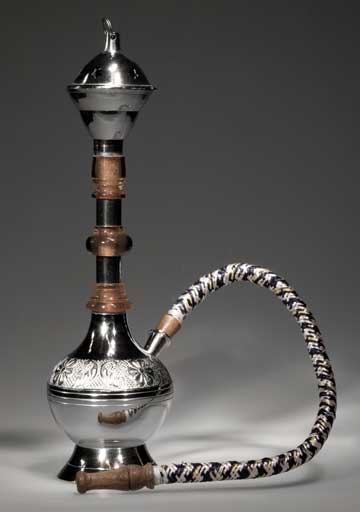 |
|||||
|
|
Fall 2013 How To Avoid the Flu This Fall Beware of the Dangers of Hookah Smoking Allergy & Asthma Network Mothers of Asthmatics Launches USAnaphylaxis Map
|
|
|
Beware of the Dangers of Hookah Smokingby Jonathan B. Waugh, PhD, RRT, RPFT, FAARC
Imagine that a friend tells you about trying something new while out with friends the night before. “We used a waterpipe called a hookah,” she says, “…and the smoke tasted sweet and spicy.” The next day you hear the sad news that your friend failed a pre-employment drug test. This possibility is becoming more likely as otherwise non-smokers are trying hookah smoking with friends since it is promoted as a social activity. The large waterpipes used in hookah bars (or special smoking areas within some restaurants) are designed for communal use and although disposable mouthpieces may be used to give a sense of hygiene, users are often unaware of what besides tobacco is added to the mixture that is heated for inhalation. Sometimes an experienced user in the group may add a compound he likes but knows others may object to, so he doesn’t mention it. Hookah may be new to many, but it has been around for centuries and is found in many countries. The practice involves using a pipe that can come in many sizes (including handheld) to create fumes that bubble through a water chamber before inhaled. Many users mistakenly think that passing the fumes through water somehow serves to filter the gas, making it safe to inhale. The 2005 World Health Organization “Advisory Note on Waterpipe Tobacco Smoking” noted that nicotine was delivered at a lower concentration in the fumes compared to cigarette smoke, but that other harmful compounds were found at higher levels in hookah users. It is thought that because the nicotine delivery in hookah smoke is more gradual, this is what allows users to smoke longer, which exposes them to higher doses of other harmful compounds in the fumes, such as carbon monoxide and benzene. In a hospital-based study published in Cancer Epidemiology, Biomarkers & Prevention, a journal of the American Association for Cancer Research, researchers at the University of California-San Francisco found that while smoking a waterpipe, the total amount of carbon monoxide in the breath measured during a 24-hour period was more than 2.5 times higher than while smoking cigarettes. This is a significant concern, as noted by investigator Peyton Jacob III, who explained that high carbon monoxide exposure increases the risk for acute events such as a heart attack, stroke, or sudden death in people who have cardiovascular or lung diseases. The volatile organic compound, benzene, was measured by a metabolite of benzene in the urine of waterpipe smokers and found at twice the amount, compared with that of cigarette smokers. Benzene exposure is known to cause leukemia in humans. The term “fume” is a better descriptor than smoke when describing what is emitted from hookah pipes. That is because the type of emission varies depending upon how close the heat source comes to the tobacco mixture. Traditionally, a piece of charcoal is placed above the bowl containing tobacco in the hookah pipe separated by a screen or piece of foil with perforations (some waterpipes have been adapted to produce a flame instead). Some users prefer to heat the tobacco just enough to produce vapors, while others heat it sufficiently to cause tobacco to burn, resulting in the addition of smoke. Either way, chemical compounds are released for inhalation. The common use of charcoal (often multiple pieces are used since sessions commonly last more than an hour) creates ash, which is mixed into the fumes that are inhaled — another source of harmful agents particularly irritating to people with sensitive airways. Electronic or e-cigarette use is growing at a surprising rate in the United States with the highest increases occurring in young people. Not to be outdone, there are now electronic or e-hookah devices (aka hookah pens or sticks) available at package and tobacco stores as well as online. A notable difference is that the flavored liquid for vaporizing in the e-hookah is sometimes available in both nicotine and nicotine-free formulations (no information is available on what proportion of liquid purchased is without nicotine). A growing workplace and public environment safety concern is the problem stemming from self-compounding of liquid vaporized in e-cigarettes and now e-hookah devices. Since anyone can mix their own liquid cartridges for use in the devices, there is no way of knowing what is in the vapor they emit (including the possibility of illegal substances). Even if someone is using commercially prepared nicotine liquid, you can still be exposed to secondhand nicotine if you inhale the vapor or absorb the vapor residue. Do not accept assurances from an e-device user that it is safe to be in their proximity when they are “vaping.” While hookah smoking frequency on average is less than that for cigarettes, when it occurs, it tends to be for a longer duration. The bottom-line is that hookah smoking exposes people to hazardous chemicals but we don’t know how dangerous the practice is compared to other forms of tobacco smoking. Be smart and steer clear of this hazard.Jonathan B. Waugh is a professor of respiratory therapy and faculty director for the Center for Teaching and Learning at the University of Alabama at Birmingham. He is also a fellow of the American Association for Respiratory Care.
|
|

